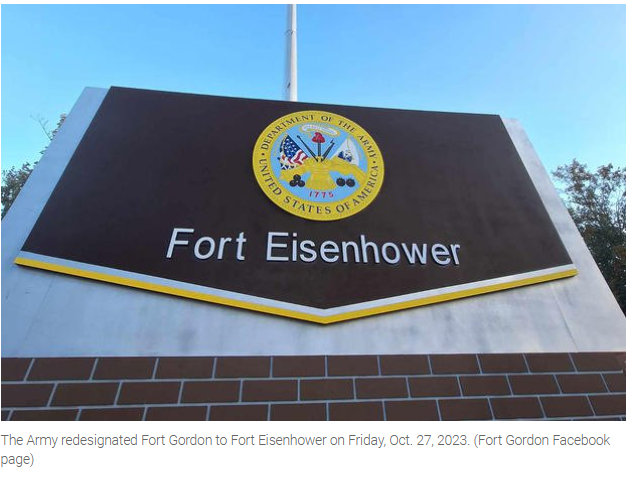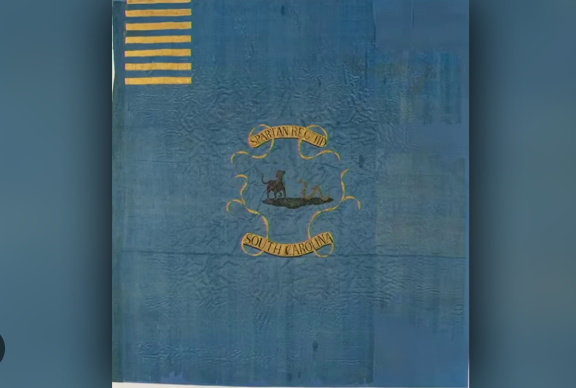WASHINGTON — Last Army Base Ditches Confederate Namesake
The Army on Friday redesignated the last of nine installations that had been named after Civil War-era Confederates, completing a process that began nearly three years ago with an order from Congress.
The final base, previously known as Fort Gordon after a Confederate lieutenant general, was renamed Fort Eisenhower during a ceremony Friday on the base’s parade field. The new namesake, President Dwight D. Eisenhower, served as the supreme allied commander in Europe during World War II, and also signed the Civil Rights Act of 1957 — the first civil rights legislation since Reconstruction — while in the White House, according to his presidential library.
The ceremony closes a chapter of history for the Army and the bases, many of which have played key military roles for generations. The scrubbing of Confederate tributes became a bipartisan effort in Congress following racial unrest across the U.S., including outcry over the police killing of George Floyd. The legislation was carried out by Defense Secretary Lloyd Austin — the first Black person to hold the top post — over the past year as the military seeks to be more inclusive.
The country’s most iconic bases — as well as some smaller, less famous facilities — were nearly all renamed for military heroes and historical figures.
Fort Cavazos in Texas, formerly Fort Hood, was renamed after a Texan who became the first Hispanic four-star general. Fort Moore in Georgia, known before as Fort Benning, took its name from Hal Moore, who fought in the battle of Ia Drang Valley during the Vietnam War, and his wife Julia, who helped develop the military’s casualty notification process and survivor support teams.
The only exception to using the namesakes of heroes and historical figures is Fort Liberty, which had previously been named Fort Bragg after a Civil War general generally considered to be a lackluster leader.
“The names of these installations and facilities should inspire all those who call them home, fully reflect the history and the values of the United States, and commemorate the best of the republic that we are all sworn to protect,” Austin said in October 2022, when he ordered the renaming process to begin.
Congress ordered the creation of the independent Naming Commission, which worked with the Pentagon to inventory all of the military’s contemporary references to the Confederacy, which waged war against the U.S. to preserve the slave trade. It found nine Army bases and several buildings commemorating rebel officers, in addition to a monument honoring Confederate soldiers at Arlington National Cemetery.
The bases were renamed one by one in ceremonies this year, ending with Fort Eisenhower on Friday.
“Rising from second lieutenant to commander-in-chief, Eisenhower’s extensive, innovative, and effective military experience and leadership shaped our modern world,” Maj. Gen. Paul Stanton, Fort Eisenhower’s commander, said in a statement. “His dedication to ensuring equal rights for soldiers and citizens alike continues to be an example and inspiration for the present and future soldiers of the Army he so faithfully served and decisively led.”
The installation is home to the Cyber Center of Excellence, the nucleus for the Army’s cyberspace operations and electronic warfare training and doctrine development.
Eisenhower finalized work started by President Harry Truman to desegregate the military.
After the Supreme Court declared school segregation was unconstitutional, the Arkansas governor deployed the National Guard in 1957 to prevent Black students from attending a historically white school in Little Rock. Eisenhower deployed the 101st Airborne Division to ensure the safety of those students, and he later federalized the Arkansas Guard.
The landmark Civil Rights Act of 1957 laid much of the foundation for basic legal protections for minorities.
The Army base’s original namesake, John Gordon, was a plantation owner and a general in the Confederate army. After the war, he served as a state legislator, senator and eventually governor of Georgia. He died in 1904.
During the Battle of Sharpsburg in Maryland, Gordon was shot five times, including in the face, by U.S. forces. Gordon, a slave owner, is largely believed to have been the leader of the Ku Klux Klan in Georgia, a rank in the group known as “Grand Dragon.”
— Steve Beynon can be reached at Steve.Beynon@military.com. Follow him on Twitter @StevenBeynon.
–military.com



